A number of years ago I found out about Mission Workshop bags while looking for a new backpack. After falling in love with the idea of the Rambler, Darcey talked me into splurging and buying it, since it did everything I wanted in a backpack. It’s now about two years later, and I wanted to write a review looking at all of the pros and cons of this bag.
In the interests of fairness, I’ll put the cons up front. This bag is definitely not for everyone: the removable hip belt is a nice feature, but I have a very round mid-section, and it sits a little too high to be completely comfortable. Perhaps once I lose some weight I’ll like it more, but for now it’s not getting much use. Moreover, even packed down to it’s 22L form, it’s a big bag. Although not especially deep, the bag is very tall, and reasonably wide. When expanded to full capacity, however, the depth becomes considerable, allowing a nearly ridiculous amount of stuff to be stowed in it. Because of the shape (much of the expansion in capacity is at the top of the bag) this can make for an unwieldy form factor. If you pack carefully, putting heavier items at the bottom and on the side closer to your back, you can mitigate this significantly, but it’s still an issue that you need to be careful in managing.
Finally on the critique side, the organisation of the bag (or lack thereof): There is one (tiny) zip pocket on the front of the bag, the main compartment, and two separate compartments that take the form of sacks that are as deep as the main compartment, and dangle into it, only given structure by their attachment at the top of the bag. This means that inevitably any small object in the bag winds up in the bottom of the abyssal pit of whichever compartment it was placed in.
All of that said, I still love this bag. Why?
First, the internal structure means that I can protect and remove a laptop with cover easily – it goes in the rear compartment, and slides in right to the bottom of the bag. It’s not competing for the same space as all of the other stuff in the bag. Or it is, but it just does it better. And it’s easy to arrange things so that the laptop compartment stays closed while you rummage in the main body of the bag without exposing the laptop to the elements. The front compartment is the same – I keep small things that would otherwise wedge themselves into books and damage pages away from the books. And the main compartment is for books. Because that’s what I carry the most as a teacher.
And it is comfortable to carry books, even when you have a ton. The straps are very well padded, and wide enough that I have never felt like they were cutting into my shoulders, even when biking with a bag full of heavy groceries, or piles of students’ notebooks for marking.
Also, the material of the bag is stiff enough that the compartments don’t just cause the exterior of the bag to collapse under their own weight. Which brings me to my next point: waterproofing. The sides have yet to soak through, even biking or walking in the rain, and while I haven’t dropped this bag in a river yet, the material that covers the face of the bag and the top flap both repel water superbly, and feels like it would stop a bullet.
In short, this bag feels like it will last as long as I care to use it. And that is backed up by a warranty for forever. Their words. It doesn’t cover usual wear, of course, but if any defect in materials or workmanship is ever detected, they will repair or replace the bag, and cover the return shipping. The bag is built like a tank, and if it falls apart I get a new one.
Finally, and perhaps my favourite feature, is the fact that it’s expandable – massively. It’s a 22L bag that unzips around the sides and fans out to a 44L behemoth.
Packed down, it’s sleek. When it packs down it has no bulges, flappy dangly bits, or loose ends. It’s still sizable, but it feels tight enough that even half-empty (or half-full for the optimistic among us) it doesn’t feel like carrying an oversized empty bag. I can put a notebook or two in there with a camera and not feel ridiculous.
Expanded, it’s almost too big for everyday use. It may not quite meet the requirements of a serious trekker, but for anything in a city it will carry what you need and then some. I use this bag to go grocery shopping on my bike, and at checkout I almost always get a double-take or two for the amount of stuff I can fit inside the bag when it’s properly packed. I might squish my bread on occasion, but I can still fit a week’s groceries in here.
So, it’s definitely not a bag everyone will like, but for the people who want versatility, flexibility, and a bag that they can do anything with, anywhere, forever… it’s amazing.
It has been almost two years since our (or should I say Darcey’s) last post. Most of that is my (Adam’s) fault, for not contributing enough to our supposedly shared blog, and some of that is just due to life getting in the way.
We are now in our third year living in China, and although we continue to enjoy being here, the demands on our time are significantly higher, between two children who are running around and demanding attention every moment they are awake, to Darcey’s enrollment in her literature program through the University of London, to my own continual disorganisation and the demands of working at a top tier international school.
The purpose of this blog was always to let our friends and family know what we are doing, as well as to hopefully share something interesting with anyone who was interested. To that end, I am going to make more of an effort to contribute regularly to updates about what we are doing, things we are enjoying, and maybe the occasional bit of general advice.
So, to recap quickly what we’ve missed posting about in no particular order:
Rohan turned 3, Asha turned 4, they spent the summer of 2017 with their grandparents in the US and Canada while Darcey and I were diving off the coast of Borneo (Sipadan was amazing!), we visited Vietnam in April 2018, we went diving in Indonesia with Pam and Dean and the kids (lovely place, less amazing when feeling the effects of winter monsoon), diving in the Perhentians with my parents, and spent the summer of 2018 visiting friends and relatives in Canada and the US.
I have also gotten much more into photography and have been trying to do more art and writing, as Darcey has stepped up her fibre-arts (acquiring both a loom and a spinning wheel) and also started a vlog.
So here is my promise: I will share something I’ve been doing, using, or enjoying – or share something on our family’s behalf – at least once a month for the next year.
All the best until the next update,
Adam
Before you arrive:
- a VPN app, either Betternet or Express VPN. Particularly if you use an Android phone, you’ll need a VPN to search or use any Google functionality unless you’re able to use a proxy or a router with VPN attached.
- Download Google Translate and download/enable Chinese for offline use. You can save phrases as well and have a custom phrasebook.
In-country:
- WeChat: Even if you’re just visiting and don’t have a SIM card, you’ll want to get WeChat if you’re going to be around for more than a day, or you expect you’ll have regular WiFi access. It’s what WhatsApp wants to be – you can order taxis, book hotels, chat with friends, read the ubiquitous QR codes, send and receive money, and more. Everyone uses WeChat; the ability to translate messages (better for the Chinese-to-English side, admittedly) is also amazingly useful.
- Explore Beijing is a very simple app: it is for navigating the subway system. You need to know the names of the stations you’re using, but you can find out how long it will take to get from A to B, the fare, an approximate duration, and any changes you’ll need to take. Definitely a must-have for getting around.
- Air Visual is a straightforward AQI (Air Quality Index) app.
- Ulmon CityMaps2Go for navigating through Beijing (or any city, frankly).
- Pleco for translation in general.
- Baidu is the default search engine in China, and on the web app you can select from using Bing, Yahoo, Baidu itself, or even (if you’re in a VPN environment) Google.
I tried to get these pictures at approximately the same time (between 8-10am), and from the same location, on days where the weather is considered “good” (e.g. sunny/not rainy) versus taking pictures on days where it would be innately overcast.
AQI 23 – Clean/Healthy – Green
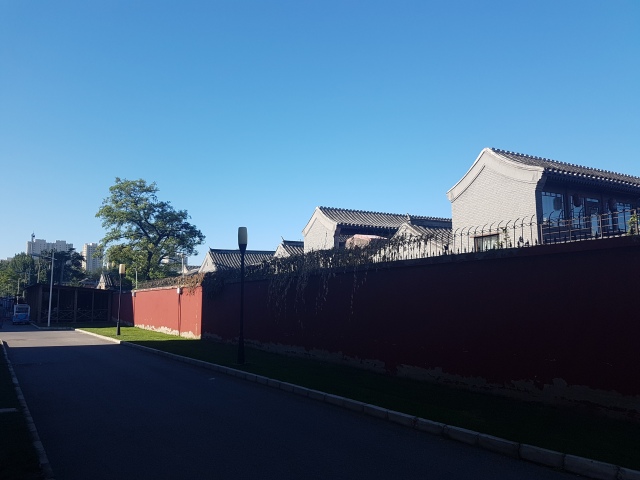
AQI 73 – Moderate – Yellow
(this picture has some clouds, because hey, they happen in nice weather and aren’t just pollution related.)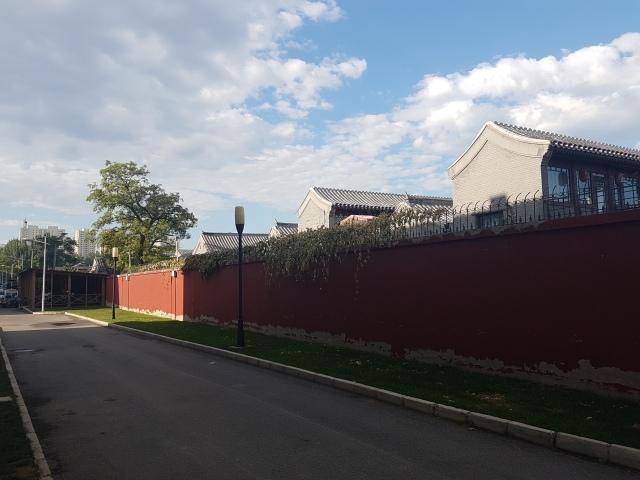
AQI 144 – Unhealthy for Sensitive People – Orange
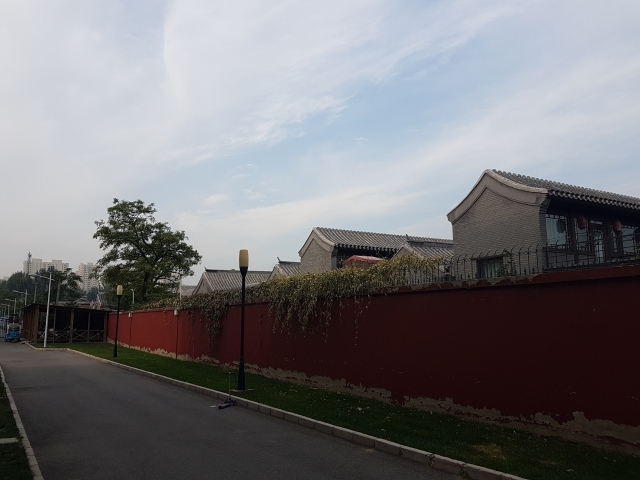
AQI 180 – Unhealthy – Red
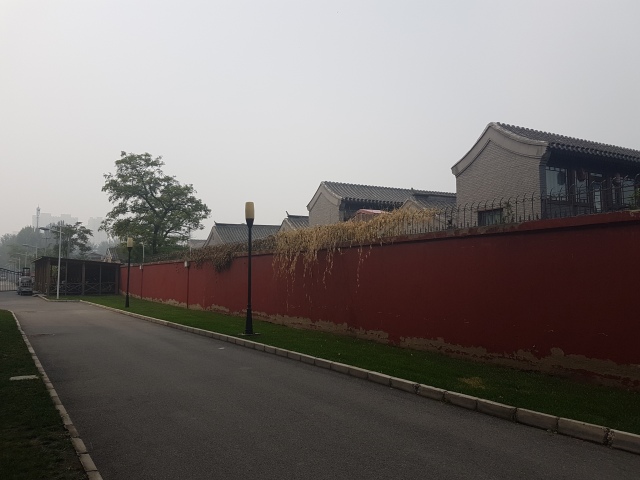
AQI 213 – Very Unhealthy – Purple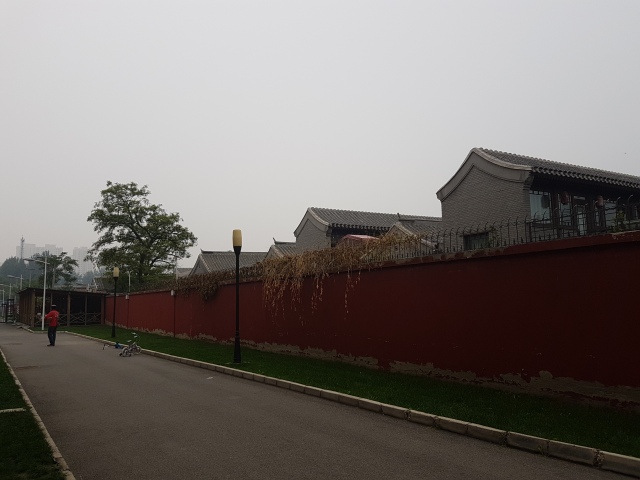
And the last one – an AQI over 250 – is Extremely Unhealthy, colour-coded brown, and we have not yet had one that I know of/snapped a picture of. There will also be days of 500+ in the winter, and one of those will come, in time.
Beijing has a very comprehensive – and well used – public transit system, featuring both subways and buses. We have taken both a few times to learn how to get around town.
This is the little “metro card” we have. They cost RMB20 and then you can put how evermuch you want to on them; trips cost from 2 to 5 kuai each way. The 20 deposit serves to effectively cover you in the event you go into the red on a given trip, and is refunded when you turn in the card.
evermuch you want to on them; trips cost from 2 to 5 kuai each way. The 20 deposit serves to effectively cover you in the event you go into the red on a given trip, and is refunded when you turn in the card.
Ours fit into our lanyards from the school, so we can have them somewhere that’s hard to lose. 🙂 They can be topped up either manually with a person in a booth, or with a machine at the station as well. If you sync it up with your phone (… I’m not entirely sure how I did it, except that I did!), it will also send periodic messages advising how much is left on your card!
The trains are very clean and usually pretty quick; we’ve only been on a few times but they haven’t had the same delays we’ve experienced as a general thing on the TTC. The signs are in English and Mandarin, as well as having line maps. As someone with kids I am immensely grateful for the fact that they aren’t open platforms: there are automated doors that open from the platform to the train, and they only open when the train is in the station and stopped.
There are actually queues – somewhat – as well as transit officers who keep an eye on everything (the man in the platform on the right). People so far have usually been good about letting people get off the train before they shove on; that said, if you have a stroller, luggage, or anything unwieldy, you’ll like as not get dirty looks (regardless of whether you’re 中国人 还是 外国人) ; it doesn’t matter if it’s rush hour or not.
We have a subway station very nearby to us – Maquanying, on Line 15 – and with only one or two transfers can get virtually anywhere in Beijing. It may take us 2 hours, or more, but we can do it!
Given that Google is verboten in China, trying to figure out a route can be tricky. Adam and I have used the app “Explore Beijing”in combination with Baidu Maps (or Google Maps, if we are able to access a VPN). Please note that in China, you cannot use Google Maps offline. You cannot even download Beijing as an offline area. Explore Beijing lets you select two subway stations and will tell you the fastest route and where to transfer; you do need to know the nearby stops (hence why you’ll need a map program to help you out to start). Baidu is exclusively in English, so you will need to have either the address in Mandarin or you’ll need to be able to use Baidu in concert with another app or website to translate text.
There are a few ways to go grocery shopping in Beijing.
1. The big chains: Beijing boasts Carrefour, Tesco, Auchan and other international supermarkets. We have been to Carrefour and Auchan and picked up things in both. They very obviously cater to the local Chinese rather than expatriates, though they include a large selection of imported goods. Carrefour, with a fish and seafood department that included the following images…
Live fish, shellfish… and eels and turtles. Because China, right?
2. Expat-targeted shops: If you’re in Shunyi or Chaoyang, you have a handful of options for buying goods – Jenny Lou’s and Jenny Wang’s are everything from milk-to-meat-and-frozen-goods type of grocery stores, with detergents and soap and kids’ toys; there are other single-product vendors (such as Schindler’s butcher shop) that are equally targeted at the expats. The school has arranged trips to Jenny Lou’s (which has a nearby branch in a place called Europlaza) and it tends to be more expensive – but is also the place you can get Skippy peanut butter, has a wine “cellar”, and various imports that Carrefour may not have.
3. Local grocery stores: Don’t expect anything in English! There are two behind the school, and they are definitively local markets for the locals, and if you go in you had best expect to know what you’re looking for! They are, of course, priced accordingly. That said – things are easy enough to find if you know what you are looking for, and to a degree even if you don’t (does it have a picture of a washing machine on it, and a white shirt that is clearly supposed to be bright white? okay, this is either bleach or washing machine powder!); cooking ingredients, however, can definitely require a translator or a printout of the words you need to find on the container.
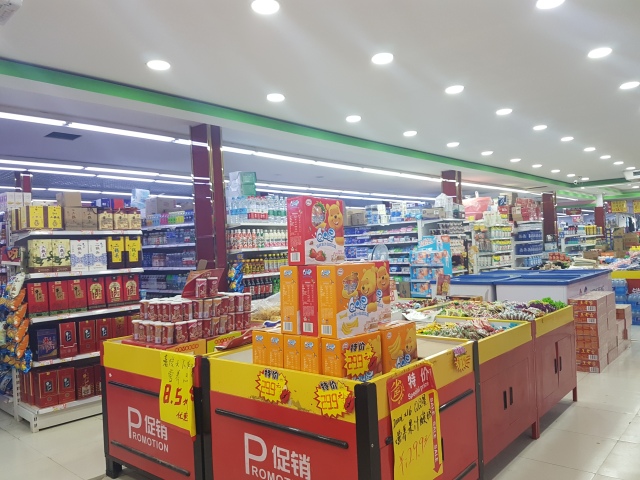
I’m not entirely certain what everything in here is, but that’s okay!
Adam and I suggest using either Pleco or Google Translate (with the OFFLINE translation features enabled!) with a smartphone; you can hold it up to the item and have characters recognized by the system, and then either get a direct translation or sort through options.
It has been a wonderful whirlwind, these first two weeks. Lots of meetings for Adam, but also Fidlers and exploration around the city.
Our apartment is still “made by IKEA” – I think everything except the stove and the in-bathroom heat lamps (… I feel like a lizard!) – came from there. We’re very happy we brought our Indian throw pillow covers with us, and our bedspreads; the apartment would look very bland without their pops of colour. We are finding things we want to pick up, day by day: clothes drying racks, tension rods for the closets, shelves, and maybe down the road a chance to nab some new furniture (a couple of chairs for the living room). We want to completely re-do Asha’s room and make it her + Rohan, but that may just have to wait until we can find out if the school can take the queen-sized bed out of that room and we can sub in an IKEA single bed.
There are lots of little shops around us, but getting out of the school compound with kids is tricky: we’re close to a subway station and two bus stops, but the scheduling makes it at least 45 minutes in one direction to go to Auchan, and more than an hour to places like Carrefour and IKEA, or the Bookworm (a Beijing English-language bookstore and expat gathering spot) and other places down near Sanlitun. Even getting to Jenny Lou’s by public transit takes over half an hour… and I have yet to try to deal with taxis or drivers, simply because of timing.
Asha is slowly settling into school; her first two days were somewhat rough so we only had her attend for half-days. She has her uniform, from shoes to dress to blazer – /and/ sport uniform /and/ swimsuit! – so we’re hoping that she settles in better after the weekend break. I am a proponent of uniforms for a few reasons, and immensely pleased we were able to do most of it through the Friends of Harrow secondhand shop. She has announced that “Mama needs school clothes!”, which we later got clarified to mean that she wants me to have a standard uniform, too. We’ll see what ends up happening, there.
We also connected with some old friends from Woodstock, the Husthwaites, over the weekend; they’re off on the other side of Beijing (almost literally). It was great to see them and to get some views of Beijing and life here from people who have been here for awhile, but not quite as long as Ash and Owen. Having different perspectives helps us balance the experiences we have, and set up well-aligned expectations.
Otherwise… it’s moving along slowly and steadily. House is coming together, we’re understanding how the metro system works, and where is best for what types of shopping and so on. Now that some of Adam’s banking situation is taken care of (oh, Bank of China…), we can start looking at using TaoBao and similar sites to handle filling in some of the blanks (like getting a printer) and deciding how to finish fleshing out the rest of the apartment to make it a little bit less “made by IKEA”. Next stop, though: framing photos and paintings we have and getting them up on the walls!
One of the school introduction events was a Peking duck dinner at a local duck restaurant. This was a pleasant surprise for me (as I’d been hoping to do it eventually), and we all went out since it was exceedingly family-friendly, and enjoyed ourselves with colleagues & lots of tasty food. This was kind of a combination banquet-plus-duck meal; you traditionally (at least, as I understand it) would not have duck plus something like this as it’s just so.much.food. Our table did not even polish off half the dishes.
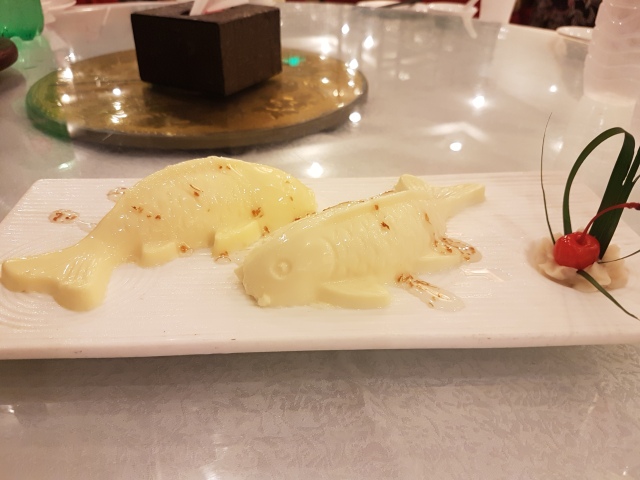
Not the least of this were these cold moulded carp(?) which came out at the start of the meal. They were a plain custard sort of thing.
The food either had amazing form and presentation like the above, or a very traditional sort of look:
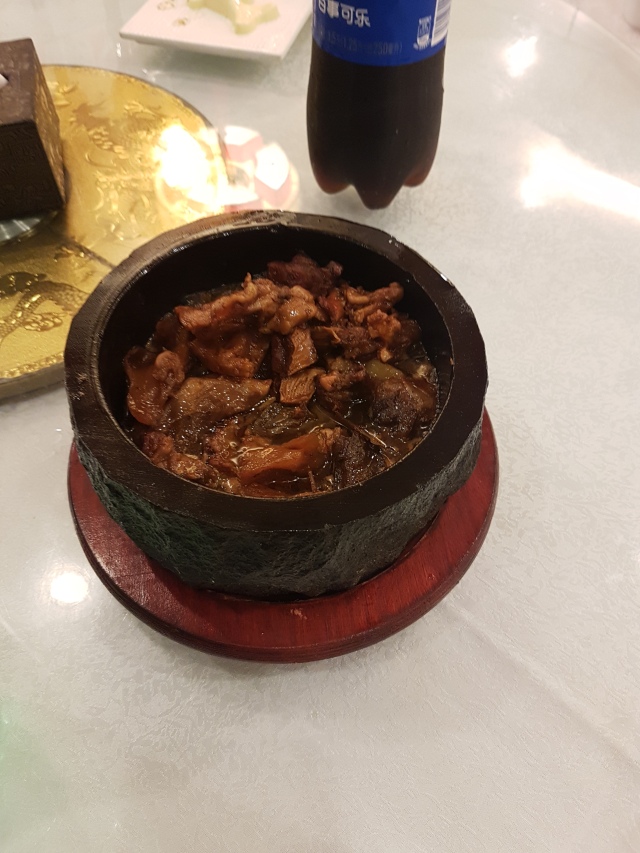
This was beef, with onions and potato, served in a big bowl. It was tasty.
Food continued – at least twelve dishes, which included but were not limited to:
- kung pao chicken (gongbaojiding)
- curry chicken ding
- slices of starch of some sort cut and stacked like a game of Jenga, drizzled with strawberry jam(!)
- cold spicy Sichuan chicken
- meatballs with hoisin dipping sauce
- the custard fish
- the beef & potato dish above
- a spicy shrimp dish
- corn and veggies
- braised tofu with sauce
- fried rice
- a whole fish, fried and covered in a sweet sauce (garlic and bean?)
- The Duck.
Oh, the duck.
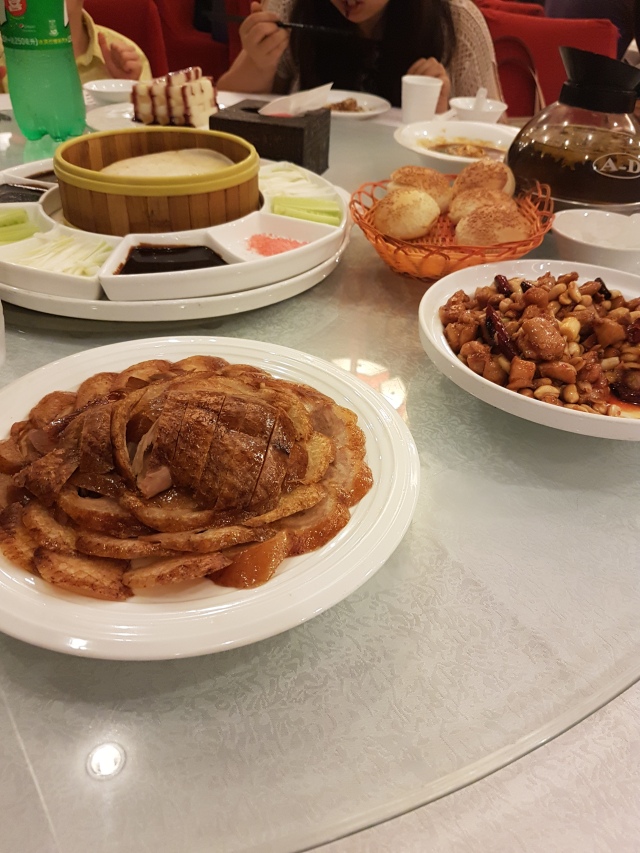
Clockwise from back: the starch-sticks with jam, spicy Sichuan chicken, gongbaojiding, and the Peking duck.
Some people have commented that there are other, better duck restaurants in the area; this was pretty good, but I’d love to see what else is in the area to find out what’s better than this!
Peking duck is traditionally served with super-thin wheat pancakes, rather like roti or crepes or tortillas; you put hoisin or a fermented black bean paste on the pancake (or you can dip the duck in it), and then put in a few slices of some ‘filler’, such as sliced scallions, cucumber, yams, or – in this peculiar case, Pop Rocks (yes, seriously, our ’90’s childhood food… it’s the pink stuff in the dish in the above picture!). It also seems to often be carved at the table for each order, but I think with six tables, we would have been sore-pressed to have that happen: I doubt there were 6 folks who could have carved simultaneously!
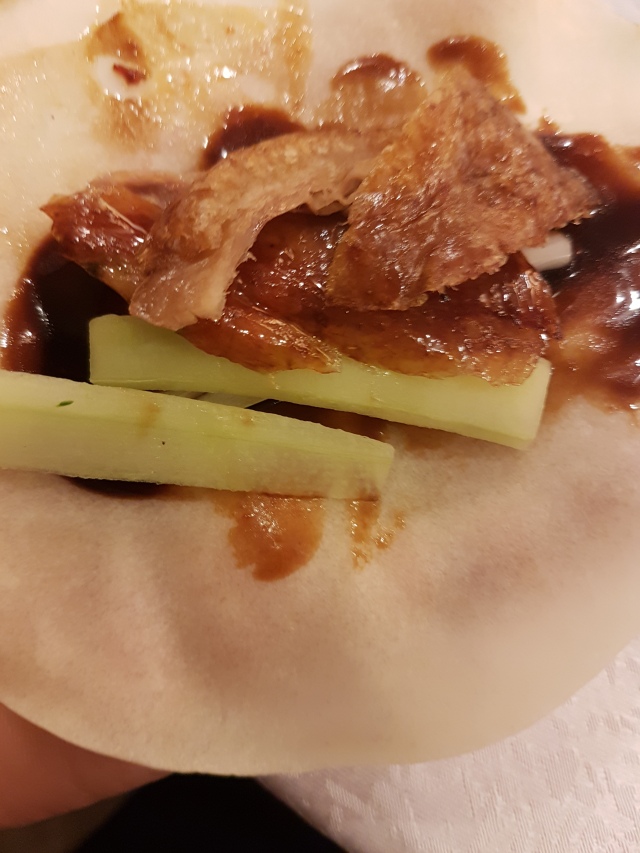
Lay a few of the pieces of duck atop the filler (each piece with a small bit of crisp duck skin), then wrap up the little duck-burrito neatly, and eat. And enjoy.
And eat, and eat, and eat.
A big meal comes to an end, in China, with a batch of fresh fruit – and that was watermelon. Asha polished off three slices on her own, before being carried home on my shoulders/Adam’s shoulders, and passing out, replete.
We followed shortly after.
There’s conversation with some friends about going to the Forbidden City & Tiananmen Square sometime in the next month – I want to go before October holidays! – and apparently, there’s a great roast duck place around there, too…
Bright and early last Monday morning, Adam and I (and the kids) hopped in a bus to be driven to a hospital about an hour away in order to undergo the medical examinations needed for our resident permits.
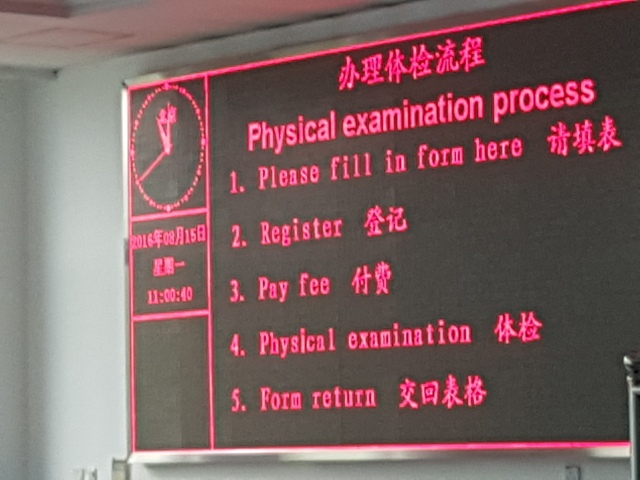
We got there around 9:30 or a bit past, and it was all done by 11!
The traffic, while quiet compared to the incessant honking of a road in India, was comparable to someplace like Toronto in terms of loudness… but with the jam-packed roads you would expect of a city with around 24 million in the metro area. An hour turned into 2 and then nearly 2.5 until we arrived at the hospital, where we hopped off and then went and stood in a queue. As we’d left at 7:30, by the time we got inside and all started to get lined up, we realised that it was probably best to schedule this for later morning or early afternoon to avoid the rush-hour traffic.
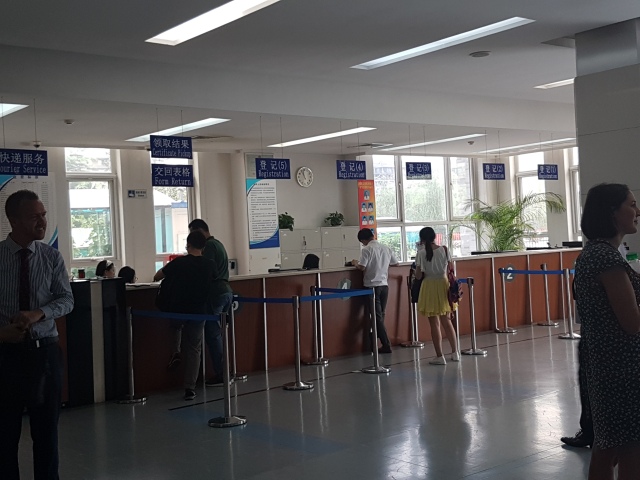
- What it looked like after all the queueing had been done. Clearly it’s best to come around lunch!
The physical examinations are required as part of the residential permit application process, and can be required for successfully receiving a visa for China as well. We had all the requisite things performed in India before we left, as did many of Adam’s colleagues. This turned out to have been great, because when we arrived, some people found out that all of their paperwork was sufficient and didn’t need to be re-checked; some people found that they needed one or two portions re-done.
That was the case for Adam and I, so we each had to go to Room 104 and Room 201 for blood draws and lung ultrasounds (for TB). Some people had to have other things done; it all depended on what was deemed acceptable or not by the person handling the registration. I imagine if you’d had none of the tests done (or needed to re-do them all) and needed to go to each room, it would have been even more time-consuming. As it was – after registration, we received slips stating what rooms we had to go to, and then we went to the rooms, handed over our paperwork, and were either gooped up in gel or stabbed with a needle. Only one thing is done in each room, so you can go room to room to room as needed and in whatever order you want to.
For anyone who may need a physical to come to China, if you can arrange to do it in your home country before you depart, I’d strongly suggest it since it will allow for less time in the medical facility when you arrive. That said, if your employer/school says to do it when you arrive – you can get it done, but it will take a fair bit of time to go through all the steps.
We left India just before monsoon, and it’s now raging full-force in Uttarakhand and Mussoorie. I’ve seen pictures from friends & acquaintances about the landslides, the leeches and the rain. One of my favourite pictures from a year or so ago is from a (now former) colleague who snapped a shot of the same location two hours apart: the top of the image is a view over the Doon Valley, and the bottom half… well, you wait for a moment, expecting the rest of the image to load.
What We Miss
- Our friends.
- Our ayah. (Who happens to be a friend, but deserves a line of her own!)
- The scenery. We like living in a city for sure – but we miss those Mussoorie mountains.
- The commute. There’s something to be said for a mandatory 2km walk, no matter how pretty the campus we’re on (and whoa, is it pretty).
- The presence of native English speakers. Even in our short time here, we have realised that – even though there are a lot of people who have studied English, the number of people who speak it is an entirely different matter.
What We Don’t Miss…
- The wilder wildlife – rhesus, scorpions, hand-sized spiders, you know.
- The intricate bureaucracy. China has some – but not to the extent/depth/insanity that India does.
- The disorganization in various things that is often excused as “India just being India”, “it’s just India, that’s how it is” – when it’s actually laziness, or an excuse to avoid doing something (or doing it well).
- The horns. For all the traffic in Beijing (it took us 2.5 hours go to a distance estimated to take 1!), it’s remarkably quiet and polite – queueing nicely, staying in lanes, etc. Most of the time. But definitely, definitely a lot quieter!








